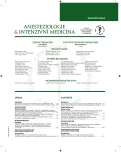The role of ultrasound in clinical decision-making and interventions in airway management
Authors:
D. Doležal; T. Novotný
Authors‘ workplace:
Klinika anesteziologie, resuscitace a intenzivní medicíny, Univerzita Karlova v Praze, Lékařská fakulta v Hradci Králové, Fakultní nemocnice Hradec Králové
Published in:
Anest. intenziv. Med., 26, 2015, č. 3, s. 161-167
Category:
Postgraduate education - ECHO didactics
Overview
The role of ultrasound in clinical decision-making and interventions in airway management has expanded during the last decade. The ultrasound modality might be used in the emergency setting thanks to better knowledge of sonoanatomy of the upper and lower airways along with the growing skills in the usage of ultrasound as well as the technological advance. As examples, ultrasound might be used to localise the cricothyroid membrane during urgent coniotomy and even during real-time navigation of intubation when laryngoscopy has failed. It can be used for the assessment of the size of the endotracheal tube, the fasting status before intubation or induction of anaesthesia, it might be applied to predict difficul laryngoscopy in obese patients and to confirm endotracheal intubation. There are many other applications like, for example, ultrasound assistence during percutaneous tracheostomy or the performance of the superior laryngeal nerve block to facilitace awake intubation. Further investigations and more evidence-based data are, however, needed to establish a consensual role of ultrasound in this area.
Keywords:
ultrasound – airways – management – perioperative care – intensive care
Sources
1. Singh, M., Chin, K. J., Chan, V. W. et al. Use of sonography for airway assessment: An observational study. J. Ultrasound Med., 2010, 29, p. 79–85.
2. Lakhal, K., Delplace, X., Cottier, J. P., Tranquart, F., Sauvagnac, X., Mercier, C. et al. The feasibility of ultrasound to assess subglottic diameter. Anaesth. Analg., 2007, 104, 611–614.
3. Ezri, T., Gewürtz, G., Sessler, D. I. et al. Prediction of difficult laryngoscopy in obese patients by ultrasound quantification of anterior neck soft tissue. Anaesthesia, 2003, 58, p. 1111–1114.
4. Komatsu, R., Sengupta, P., Wadhwa, A. et al. Ultrasound quantification of anterior soft tissue thickness fails to predict dif-ficult laryngoscopy in obese patients. Anaesth. Intensive Care, 2007, 35, p. 32–37.
5. Wojtczak, J. A. Submandibular sonography: assessment of hyomental distances and ratio, tongue size, and floor of the mouth musculature using portable sonography. J. Ultrasound Med., 2012, 31, p. 523–528.
6. Adhikari, S., Zeger, W., Schmier, C. et al. Pilot study to determine the utility of point-of-care ultrasound in the assessment of difficult laryngoscopy. Acad. Emerg. Med., 2011, 18, p. 754–758.
7. Elliott, D. S., Baker, P. A., Scott, M. R. et al. Accuracy of surface landmark identification for cannula cricothyroidotomy. Anaesthesia, 2010, 65, p. 889–894.
8. Nicholls, S. E., Sweeney, T. W., Ferre, R. M., Strout, T. D. Bedside sonography by emergency physicians for the rapid identification of landmarks relevant to cricothyrotomy. Am. J. Emerg. Med., 2008, 26, p. 852–856.
9. Ma, G., Davis, D. P., Schmitt, J. et al. The sensitivity and specificity of transcricothyroid ultrasonography to confirm endotracheal tube placement in a cadaver model. J. Emerg. Med., 2007, 32, p. 405–407.
10. Jacoby, J., Smith, G., Eberhardt, M., Heller, M. Bedside ultrasound to determine prandial status. Am. J. Emerg. Med., 2003, 21, p. 216–219.
11. Perlas, A., Chan, V. W., Lupu, C. M. et al. Ultrasound assessment of gastric content and volume. Anesthesiology, 2009, 111, p. 82–89.
12. Cubillos, J., Tse, C., Chan, V. W., Perlas, A. Bedside ultrasound assessment of gastric content: an observational study. Can. J. Anaesth., 2012, 59, p. 416–423.
13. Lichtenstein, D., Biderman, P., Meziere, G., Gepner, A. Sinusogram, a real time ultrasound sign of maxillary sinusitis. Intensive Care Med., 1998, 24, p. 1057–1061.
14. Liu, K. H., Chu, W. C., To, K. W. et al. Sonographic measurement of lateral parapharyngeal wall thickness in patients with obstructive sleep apnea. Sleep, 2007, 30, p. 1503–1508.
15. Lahav, Y., Rosenzweig, E., Heyman, Z. et al. Tongue base ultrasound: a diagnostic tool for predicting obstructive sleep apnea. Ann. Otol. Rhinol. Laryngol., 2009, 118, p. 179–184.
16. Barberet, G., Henry, Y., Tatu, L. et al. Ultrasound description of a superior laryngeal nerve space as an anatomical basis for echoguided regional anaesthesia. Br. J. Anaesth., 2012, 109, p. 126–128.
17. Marciniak, B., Fayoux, P., Hébrard, A. et al. Airway management in children: ultrasonography assessment of tracheal intubation in real time? Anesth. Analg., 2009, 108, p. 461–465.
Labels
Anaesthesiology, Resuscitation and Inten Intensive Care MedicineArticle was published in
Anaesthesiology and Intensive Care Medicine

2015 Issue 3
Most read in this issue
- Anaesthetic management of the hypotonic uterus
- PRES (Posterior reversibleencefalopathy syndrome) in a pre-eclamptic woman with twin pregnancy – case report
- Biological treatment and the risk of perioperative complications
- Preoperative examination of the autonomic nervous system by measurement of the heart rate variability for prediction of the perioperative course
